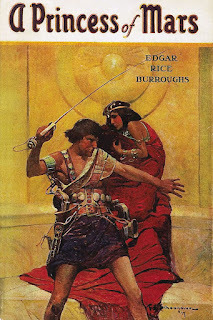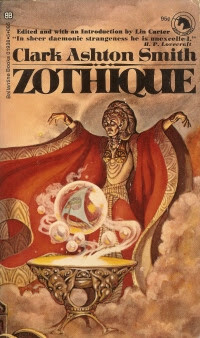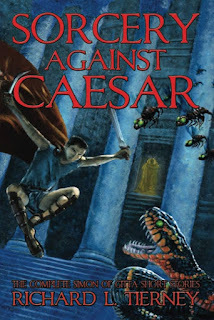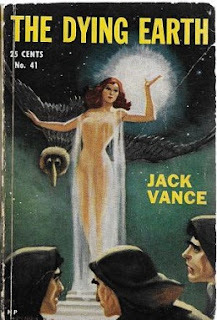sha-Arthan Appendix N (Part I)
Last week, I pointed out a "problem" with Gary Gygax's Appendix N, namely, it's just a list without any explanatory apparatus, unlike its counterpart in the original RuneQuest. As I explained in that post, this is far from a damning criticism – Appendix N remains an invaluable guide to excellent fantasy and science fiction stories – but it does limit its utility in trying to understand Gygax's own thought processes as he created both D&D and AD&D.
That's why I decided I'd do things differently in Secrets of sha-Arthan. Rather than simply include a lengthy list of all the books (and games) that had had even the tiniest influence over my own work on SoS, I'd instead present a smaller, more focused list, along with commentary on precisely what I'd taken from each source. The goal is not merely to honor my inspirations, but also to aid anyone who picks up the game in understanding where I'm coming from.
The list, like the game itself, is still in a state of low-level flux. I've purposefully narrowed the list to just four authors, each of which wrote a series of multiple stories within those series. By keeping the list focused on those whose influence is strongest and most clear, I hope that I'll do a better job than Gygax of "showing my cards," creatively speaking. Obviously, other authors and books have inspired me, too, but their inspiration has been more limited. Rather than muddy the waters, I've stuck only with whose influence is most clear.
 Burroughs, Edgar Rice: The influence of Edgar Rice Burroughs over the subsequent history of fantasy cannot be underestimated. His Barsoom novels in particular have played a huge role in establishing the broad outlines of that genre and the stories and characters that inhabit it. Everything from building a unique setting, with its own history and geography to populating it with all manner of exotic cultures and beasts to even presenting an alien vocabulary, it's all there in A Princess of Mars, a book not much read today but that I have come to love more the older I get.
Burroughs, Edgar Rice: The influence of Edgar Rice Burroughs over the subsequent history of fantasy cannot be underestimated. His Barsoom novels in particular have played a huge role in establishing the broad outlines of that genre and the stories and characters that inhabit it. Everything from building a unique setting, with its own history and geography to populating it with all manner of exotic cultures and beasts to even presenting an alien vocabulary, it's all there in A Princess of Mars, a book not much read today but that I have come to love more the older I get.In creating sha-Arthan, I often looked to Barsoom and Amtor for inspiration, particularly in my conception of the creatures that dwell upon it. Furthermore, the Ironian language is intended to be reminiscent of the Martian tongue as invented by Burroughs. I also imagine adventures in the True World to be swashbuckling affairs, filled with perilous danger, narrow escapes, and feats of derring-do, just like the delightful novels of ERB.

Smith, Clark Ashton: Of all the writers whose work graced the pages of Weird Tales during the Golden Age of the Pulps, Clark Ashton Smith remains my favorite by far. His examination of the dangers of egotism and the ever-present risk of divine punishment combine with his black humor and imaginative dreamscapes to produce some of the most inventive – and often terrifying – fiction of the first half of the 20th century. Though I am fond of all his story cycles, it's those set in Zothique, Earth's last continent untold eons in the future, that I find most compelling.
There's more than a little of Zothique in sha-Arthan. Its ancient history, selfish sorcerers, and otherworldly daimons are all directly inspired by CAS. Smith's baroque and archaic vocabulary have likewise influenced the nomenclature and general tone of my writing about the setting. Though sha-Arthan is not as dark (or darkly humorous) as Zothique, it does possess some of the latter's world-weariness,
 Tierney, Richard L.: Secrets of sha-Arthan takes a lot of inspiration from the late Hellenistic and early Roman eras. That's a period of history that's always fascinated me, so that's no surprise. It's also the time period covered by the Simon of Gitta historical fantasies of Richard L. Tierney, some of whose stories I've discussed in the past.
Tierney, Richard L.: Secrets of sha-Arthan takes a lot of inspiration from the late Hellenistic and early Roman eras. That's a period of history that's always fascinated me, so that's no surprise. It's also the time period covered by the Simon of Gitta historical fantasies of Richard L. Tierney, some of whose stories I've discussed in the past.
Tierney's stories deftly combine real world history and beliefs, particularly those relating to Gnosticism, with an unusual interpretation of H.P. Lovecraft's Cthulhu Mythos and swashbuckling adventure. This combination of elements is both unique and appealing to someone of my interests, which is why I consider the Simon of Gitta tales to be among the most important influences on my development of sha-Arthan as a RPG setting.
 Vance, Jack: Rounding out this quartet of inspirational authors is Jack Vance, creator of The Dying Earth and its sequels, all of which have, to varying degrees, influenced sha-Arthan, though the original 1950 fix-up novel remains the most important. Like Smith's Zothique stories, I've looked to Vance for ideas about ancient, forgotten history, venal wizards, and cruel, otherworldly beings. However, the single most significant idea I've taken from Vance is that of secret science fiction, which is to say, an ostensibly fantasy setting that is, beneath the surface, based on scientific (or pseudo-scientific) principles. That's a big part of sha-Arthan and its eponymous secrets.
Vance, Jack: Rounding out this quartet of inspirational authors is Jack Vance, creator of The Dying Earth and its sequels, all of which have, to varying degrees, influenced sha-Arthan, though the original 1950 fix-up novel remains the most important. Like Smith's Zothique stories, I've looked to Vance for ideas about ancient, forgotten history, venal wizards, and cruel, otherworldly beings. However, the single most significant idea I've taken from Vance is that of secret science fiction, which is to say, an ostensibly fantasy setting that is, beneath the surface, based on scientific (or pseudo-scientific) principles. That's a big part of sha-Arthan and its eponymous secrets. In Part II, I'll talk about the other roleplaying games that have influenced the development of Secrets of sha-Arthan. For obvious historical reasons, this is something Gygax could never have done. However, I've played enough RPGs over the years that there's no question they've had as much of an impact on my thoughts about sha-Arthan as has fantasy literature. Revealing just what I've taken from them is, I think, every bit as important as revealing my literary inspirations.
James Maliszewski's Blog
- James Maliszewski's profile
- 3 followers



